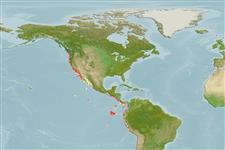>
Gadiformes (Cods) >
Macrouridae (Grenadiers or rattails)
Etymology: Nezumia: A Japanese word that means "mouse"; stelgidolepis: stelgidolepis meaning scraper scale, referring to the rasplike scales that cover the body (Ref. 4525).
More on author: Gilbert.
Environment: milieu / climate zone / depth range / distribution range
Ecologia
marinhas batidemersal; não migratória; intervalo de profundidade 277 - 909 m (Ref. 1371). Deep-water; 49°N - 16°S, 130°W - 76°W (Ref. 1371)
Eastern Pacific: off Vancouver Island, Canada to southern Peru.
Tamanho / Peso / Idade
Maturity: Lm ? range ? - ? cm
Max length : 84.0 cm TL (female)
Descrição suscinta
Chaves de identificação | Morfologia | Morfometria
Espinhos dorsais (total) : 2; Espinhos anais: 0. Snout short, narrow, bluntly pointed; terminal snout scute developed but not conspicuously; suborbital ridge low; underside of snout, most of the suborbital region, and anterior half of mandible without scales; cephalic pores of the lateralis system prominent. Pyloric caeca 24 to 58. Body scales densely covered with conical to narrowly lanceolate spinules in short, slightly convergent rows. Overall color is swarthy, blackish ventrally, with bluish tinge on abdominal region; oral and branchial cavities generally pale with some blackish areas; fins dusky to blackish, first dorsal fin slightly paler basally.
Food items are generally forcibly regurgitated by the fish's expunging gas bladder as it is hauled from the depths, but fish remains have been caught inside the mouth of a few individuals. Considered opportunistic feeders and will eat whatever animal food they encounter in the natural habitat as long as it is of appropriate size (Ref. 4525).
Ciclo de vida ou comportamento de acasalamento
Maturidade | Reprodução | Desova | Ovos | Fecundidade | Larvas
Cohen, D.M., T. Inada, T. Iwamoto and N. Scialabba, 1990. FAO species catalogue. Vol. 10. Gadiform fishes of the world (Order Gadiformes). An annotated and illustrated catalogue of cods, hakes, grenadiers and other gadiform fishes known to date. FAO Fish. Synop. 125(10). Rome: FAO. 442 p. (Ref. 1371)
Status na Lista Vermelha da UICN (Ref. 130435: Version 2024-2)
Ameaça para os humanos
Harmless
Uso pelos humanos
Pescarias: pouco comercial
Ferramentas
Relatórios especiais
Baixar XML
Fontes da internet
Estimates based on models
Preferred temperature (Ref.
123201): 5 - 9.8, mean 8.4 °C (based on 47 cells).
Índice de diversidade filogenética (Ref.
82804): PD
50 = 0.5000 [Uniqueness, from 0.5 = low to 2.0 = high].
Bayesian length-weight: a=0.00214 (0.00123 - 0.00371), b=3.18 (3.03 - 3.33), in cm total length, based on LWR estimates for this species & (Sub)family-body (Ref.
93245).
Nível Trófico (Ref.
69278): 4.4 ±0.80 se; based on food items.
Generation time: 5.5 ( na - na) years. Estimated as median ln(3)/K based on 1
growth studies.
Resiliência (Ref.
120179): médio(a), tempo mínimo de duplicação da população 1,4 - 4,4 anos (K=0.20).
Fishing Vulnerability (Ref.
59153): Moderate to high vulnerability (51 of 100).
